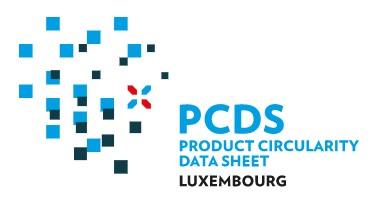Are you overwhelmed by the different sustainability and circularity certificates, standards & frameworks that are emerging? If you're unsure which ones are meant for you and what the differences are between them - this blog helps breaks down the five most common reports to answer those questions. We take a look at different common reports & labels created on Toxnot to help you breakdown which ones might makes sense for you.
These reports & labels are:
- Declare Labels
- LEED v4
- Health Product Declaration (HPD)
- Product Circularity Data Sheets (PCDS)
- Environmental Product Declarataion (EPD)
What is a Declare Label?
Declare Labels are like a nutrition label for a building product. The Labels are managed and reviewed by International Living Future Institute but are built on Toxnot as their sole technology partner. Declare Labels are designed to help Material Purchasers quickly identify products that meet their project requirements.

The label itself includes categories such as final assembly locations, life expectancy, end-of-life options, and overall compliance with relevant requirements of the Living Building Challenge (LBC). The ingredients in the product must be disclosed at a threshold of 100ppm or above. Each ingredient must have a chemical name, CAS # and percentage weight.
What is LEED v4?
LEED stands for Leadership in Energy and Environmental Design. The organization was founded in 1993 to create an open coalition for the entire building industry and to create a green building rating system. The first version of LEED was launched in 1998. LEED has 7 credit categories, the main focus at Toxnot is ‘Materials and Resources’, others include Location and Transportation, Sustainable Sites, Water Efficiency, Energy and Atmosphere etc. At a high level, LEED Certifications address all buildings, spaces and communities. Building project managers use the LEED framework to define and achieve goals that benefit the project’s local community and the planet.
If you are a manufacturer of a building material, you can create a LEEDv4 Material Disclosure & Optimization Form, request third party approval, and publish it directly to Origin for approval. When working with customers that are looking to gain LEED certification, these documents help with the Materials and Resources Category. The LEED report can be created on Toxnot.
What is an Health Product Declaration (HPD)?
HPD stands for Health Product Declaration, it is a self declared list of ingredients as claimed by the product manufacturer. It is relevant for products used in the built environment.
The label itself contains an inventory of chemical substances which are characterized by the level of concern for each ingredient. The majority of the chemicals are disclosed by the manufacturer in the interest of providing greater transparency. The goal is for architects and relevant building related constituents to be well informed in order to make educated purchasing decisions. HPDs are one of the most common ways to gather documentation for LEED v4 and v4.1. HPDs are also used for WELL building Certification, specifically for the Feature 97 that requires at least 50% of interior finishes, materials and furnishings to be evaluated and disclosed. The HPD standard was created by the NGO Health Product Declaration Collaborative, more information can be found on their website. HPDs can be created on the HPD Builder or on Toxnot.
What is a Product Circularity Data Sheet (PCDS)?
PCDS stands for Product Circularity Data Sheet. The PCDS report establishes an official standard for a product’s supply chain circularity data. The standard is designed to convey data related to the type of end-of-use cycle a product should belong to. The PCDS aims to answer the question: should the product be reused, reparaired, recycled or enter a material bank for new products?
The intent is to communicate data on circular properties of a product so that consumers and manufacturers can make educated decisions about a product. The report is broken down into 5 different sections and consists of a list of ‘yes’ or ‘no’ statements along with guidance for each statement. The data in the report does not require confidential data, it is machine readable and automatically assembled when completed on Toxnot. The document also contains the definition of specific terms following ISO/CEN standards and International/EU regulations. Lastly, it shows how or if the data was audited. The standard was developed by the Ministry of the Economy of Luxembourg with their partner Positive ImpaKT consultancy and 50+ other industry, NGO and government agency representatives.
What is an Environmental Product Declarataion (EPD)?
EPD stands for Environmental Product Declaration. EPDs are the final report and serve as the foundation for a Life Cycle Assessments (LCAs). These are extensive and involved reports that summarize the environmental impact of a product. They are considered type III environmental declaration compliant with ISO 14025 standard. The document itself consists of two key pieces, the background project report that is private and the public EPD document that lists the results.
EPD are more intensive and do not compare to the other certificates listed above including Declare labels, HPDs, and PCDSs because they are not self declared and cover the full Life Cycle Assessment of a goods and services rather than just the material composition data. Furthermore, there are no restrictions regarding what industry or products can have EPDs. Lastly, whereas the self declared reports can be third party verified if the manufacturer desires, these reports are third party verified as a rule. Although you can gather and manage embodied carbon at a product level on Toxnot, you cannot create an EPD on Toxnot.
Safe & Sustainable Starts Today
The sustainability of your products starts by knowing what hazards and chemicals exist in your supply chain materials. Meeting your ESG goals is easy with Toxnot. Start by signing up for a free account today to streamline access to supplier data and instantly generate your sustainability reports.


